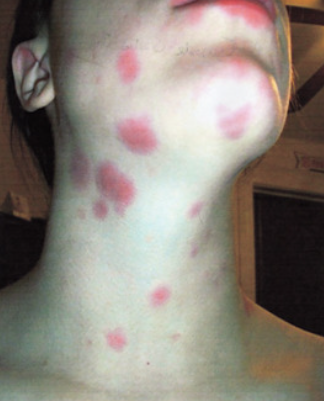Autoimmune progesterone dermatitis is a rare skin disorder characterized by premenstrual flares and increased sensitivity to progesterone. It is coded as L30.8 in ICD-10.
The condition is observed in women of reproductive age, typically between the ages of 20 and 40, although cases have been reported in adolescents. Sometimes the first signs appear after pregnancy. Autoimmune progesterone dermatitis is a rare form of hormonal allergy, specifically an increased sensitivity to sex hormones, in which there is an autoimmune response to natural progesterone mediated by TH1 cytokines. In 75% of cases, the onset of the disease is preceded by the use of oral contraceptives containing progesterone.
A leading hypothesis regarding the pathogenesis of the disease is that synthetic progesterone possesses antigenicity, leading to the production of antibodies that subsequently cross-react with natural progesterone, resulting in an immune response during the premenstrual period when its levels increase. It is also possible that pregnancy, during which progesterone levels rise, may lead to sensitization to progesterone.Autoimmune progesterone dermatitis presents with a wide range of clinical manifestations, but intense itching is a characteristic symptom. The most common manifestations include pruritic urticarial pink-red papules, less frequently papulovesicular plaques, and target-like erythematous patches. The rash may occur anywhere on the body, but more commonly on the trunk and extremities, and less commonly on the face. It can be unilateral or symmetrical. Many patients have small erosions on the oral mucosa. The appearance of the rash can resemble eczema, erythema multiforme, urticaria, dyshidrosis, or herpetiform dermatitis.
In very rare cases, laryngospasm and anaphylaxis may occur. Typically, the dermatosis worsens in the second half of the menstrual cycle, reaching its peak before menstruation and gradually decreasing with the onset of menstruation. During the first half of the menstrual cycle, the rash is usually absent or mild. The disease tends to worsen during pregnancy. Cases of prolonged remission and spontaneous recovery have been reported.The diagnosis is based on clinical data and the cyclic nature of the disease. Allergen testing is used for diagnosis and is conducted during the first half of the menstrual cycle:
Intracutaneous testing involves injection of a 0.01% aqueous suspension of progesterone (50 mg/mL). A positive reaction in the form of erythema and wheal may be immediate (within 30 minutes) or delayed (within 24-96 hours). In addition to intradermal progesterone injection, an estrogen test (saline and estrone 1 mg/ml) is often used to monitor and diagnose estrogen dermatitis. Intramuscular testing involves the injection of gestone at a dose of 25 mg/ml. A positive reaction in the form of rash appearance or exacerbation is observed within 24-48 hours after the injection. Oral testing involves the administration of dydrogesterone 10 mg daily for 7 days. A positive reaction in the form of rash appearance or exacerbation occurs during the treatment period. Biopsy is rarely performed due to lack of specific changes. Vacuolar interface dermatitis with dense and deep perivascular and perifollicular lymphocytic infiltrates and a few eosinophils may be observed.- Chronic urticaria
- Allergic contact dermatitis
- Erythema multiforme
- Familial Mediterranean fever
- Hyperimmunoglobulin D syndrome
- Familial cold urticaria
- MacLeod's syndrome

